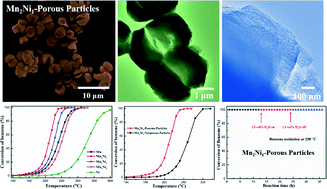Importance of porous structure and synergistic effect on the catalytic oxidation activities over hierarchical Mn–Ni composite oxides†
Abstract
Hierarchically porous manganese–nickel composite oxides (MNCOs) were successfully synthesized by an oxalate route and further applied for catalytic removal of benzene. Among these catalysts, the best one was Mn2Ni1 mixed oxides which exhibited uniform hierarchical lithops-like topography, a rich porous structure and a high surface area of 201.1 m2 g−1. The temperature required for a benzene conversion of 90% over this catalyst was ca. 232 °C under the conditions of a benzene concentration of 1000 ppm in air and a high space velocity of 120 000 mL g−1 h−1, which was 54 °C lower than that over the non-porous MNCO particles prepared by a traditional approach. The reaction kinetic study showed that the apparent activation energy (45.2 kJ mol−1) for the total oxidation of benzene over the Mn2Ni1 oxide catalyst was much lower than those (72.4–97.2 kJ mol−1) over other catalysts. With XPS and H2-TPR analyses, the porous MNCOs have a higher content of surface-adsorbed oxygen species and better low-temperature reducibility which can be ascribed to a possible synergetic effect between Mn and Ni ions in the spinel mixed oxides.


 Please wait while we load your content...
Please wait while we load your content...